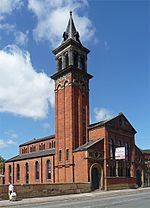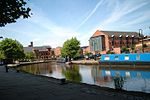Three60, Manchester
Apartment buildings in EnglandBuildings and structures in ManchesterGreater Manchester building and structure stubsResidential buildings in ManchesterResidential skyscrapers in England ... and 3 more
Skyscrapers in ManchesterUnfinished buildings and structuresUse British English from February 2023

Three60 is a cylindrical residential skyscraper under construction in Manchester, England. The building is part of the second phase of the Crown Street development area at the southern end of Deansgate in the city centre, behind the Deansgate Square skyscraper cluster. It was designed by SimpsonHaugh architects. When completed, at 154 m (505 ft) tall, the 51-storey tower will be the joint fourth-tallest building in Greater Manchester alongside its sister tower The Blade.
Excerpt from the Wikipedia article Three60, Manchester (License: CC BY-SA 3.0, Authors, Images).Three60, Manchester
Mancunian Way, Manchester Hulme
Geographical coordinates (GPS) Address Nearby Places Show on map
Geographical coordinates (GPS)
| Latitude | Longitude |
|---|---|
| N 53.47151 ° | E -2.2547 ° |
Address
Mancunian Way
Mancunian Way
M15 5RR Manchester, Hulme
England, United Kingdom
Open on Google Maps








